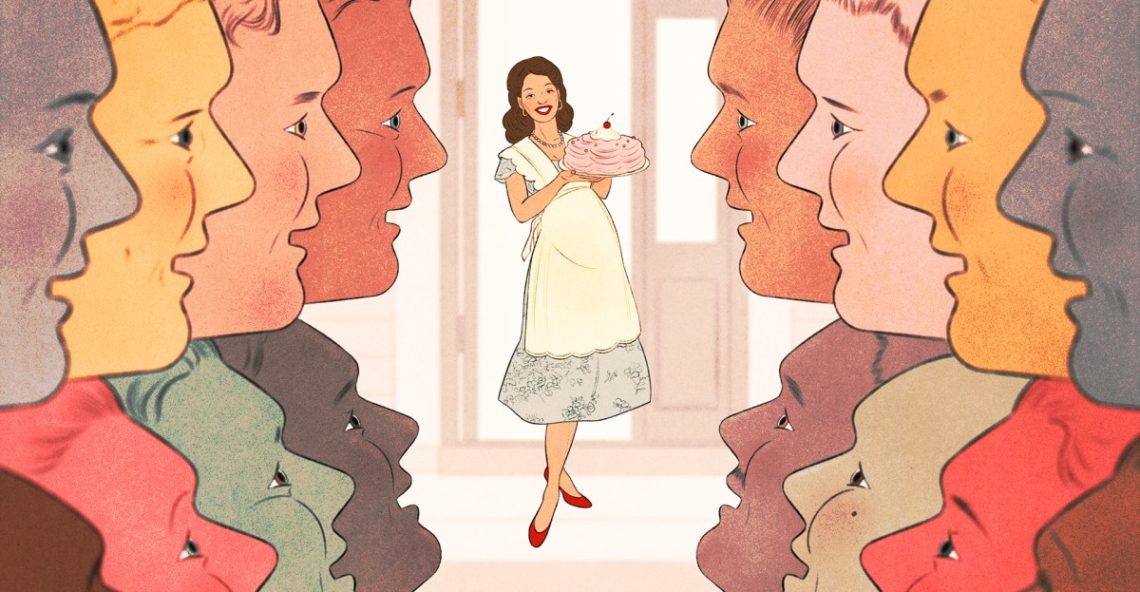Daniel and Brianna Bell met as college students near Toronto. Brianna, especially, had embraced traditionalist messages about family from her conservative Christian church. So when they married, Daniel became a pastor and Brianna became a stay-at-home mom.
Brianna lived what was essentially a “tradwife” lifestyle — the trend popularized by online influencers in which women embrace conservative gender roles in their families. For her, that meant making her own laundry detergent, being gentle and meek, and prioritizing her husband, kids, and God over herself at every turn, she told me. For Daniel, the traditional life was a little more complicated.
On the one hand, “I felt like I never had to cook,” he told me. “I barely had to clean.”
On the other, he was faced with the task of providing for his entire household on a pastor’s salary, sometimes as low as $9,000 a year. He described the intense pressure of “feeling like I want to give my family the life they desire” but knowing that was “impossible on one income in the world that we lived in.”
The financial struggles were just one aspect of trad life that began to chafe at the Bells over time. “A big perspective of that subculture is that men have the final say and the authority,” Bell said. “I never really felt like that was practical.”
Bell’s experience reveals some of the contradictions inherent in being a “trad husband” — a role that receives little public discussion despite the visibility of online tradwives. The idea of the tradwife doesn’t exist without a husband; he’s the head of the household, the one to whom everyone else is supposed to submit. Yet the husbands of popular tradwife influencers typically trail their wives in popularity, and almost all discourse around “traditional” gender roles focuses on the decisions and activities of women. “Trad husbands” are so invisible that even the term demands quotation marks. In interviews for this story, I often had to explain what I meant by it.
The invisibility of the trad husband reflects a larger vacuum when it comes to men’s roles in debates about family policy and culture. In an era of declining birth rates, conservative politicians and activists (most of them male) have put a lot of energy into influencing women’s behavior. It’s less clear, however, what these new traditionalists believe men are supposed to do — especially in an era when being a sole breadwinner is more difficult than ever. In 2025, do young men even want to be trad husbands? And if not, what do they want to do instead?
Where are the trad husbands?
Tradwife content is often ostensibly aimed at women, with some influencers offering explicit tips for life as a stay-at-home wife and mother. Indeed, it’s hard to exist as a woman on the internet without being served a tradwife video at some point, and the footage of relaxed moms and cute children performing photogenic chores in beautiful, curated spaces can draw in even the least trad-aligned viewer.
These videos make an implicit promise to the women watching them — a promise that a life of calm and beauty is available to them, if they only make the right choices. Marriage is part of that promise. One message of tradwife content is, “if you look a certain way, if you prioritize domesticity, children, and traditional feminine pursuits, you will be gifted a supportive husband who provides for you and who cherishes you,” said Sara Petersen, author of Momfluenced: Inside the Maddening, Picture-Perfect World of Mommy Influencer Culture.
But the husbands themselves are secondary characters. When they appear in their wives’ online posts, it’s usually as a kind of “beneficent background figure,” there to show how blissful traditional marriage can be without drawing too much attention to themselves, Petersen said.
As influencers in their own right, trad husbands typically come in a distant second to their wives. Hannah Neeleman (@ballerinafarm) has more than 10 million followers on Instagram as of this writing; her husband Daniel, son of JetBlue founder David Neeleman, has more than 650,000. If tradwives are talking to women about how to live their lives, their husbands aren’t really talking to men — or, at least, men aren’t listening.
Some of that is probably because the men are all watching tradwife videos. Jessica Grose at the New York Times has wondered whether the main audience for these influencers is actually conservative-leaning men, and a lot of tradwife content — videos depicting women getting ready for their husbands to come home, for example — feels calibrated for the male gaze.
“The tradwife is such a visual artifact,” Petersen said. “She really exists to be looked at and to be perceived.”
The labor these influencers perform is also deeply visual, from picking flowers to making DIY versions of popular processed snacks. As with home canning influencers, their work is hands-on and analog in a way that’s appealing to a lot of viewers in an economy that increasingly revolves around screens.
Where does the work of the trad husband fall in all this? Being a breadwinner isn’t as aesthetically pleasing as being a bread-maker — tradwives and the Trump administration’s rhetoric alike hark back to a fantasy of the 1950s, but some of the most famous art of the 20th century is about how dull and soul-destroying the life of the 1950s “company man” could be. Nobody really wants to watch a dad come home from the office and smoke his pipe.
Physically demanding jobs in agriculture, construction, or manufacturing are probably the closest analogue to the highly gendered domestic work tradwife content creators perform. The trad husbands who do maintain Instagram presences often chronicle their lives as farmers or homesteaders. Daniel Neeleman (@hogfathering on Instagram) posts a lot of videos of cows, sheep, and pigs, for example. Singing the praises of the blue-collar man is also a perennial trend on TikTok.
But the kinds of male-coded jobs that make good content are exactly the kinds of jobs that are rapidly disappearing in America, or that have already disappeared.
What does a trad husband do?
“The male breadwinner has been declining for a long time,” said Pamela Aronson, a sociology professor at the University of Michigan Dearborn and the author of Gender Revolution: How Electoral Politics and #MeToo Are Reshaping Everyday Life. Whereas in the 1960s many men could support a family with a job in manufacturing, today “that’s completely gone.”
Manufacturing jobs in America have been on a decades-long decline, one exacerbated rather than stemmed in recent months by President Donald Trump’s trade policies. Agricultural jobs have been on a similar slide, and it’s incredibly difficult to support a family as a small-scale farmer in the United States today.
Today, young men, especially those without a college education, often end up in low-skilled service sector jobs, which provide little stability, Aronson said. These are jobs that make being the sole breadwinner for a family nearly impossible.
Even for men who can make the sole-breadwinner model work, doing so in a deeply uncertain economy involves enormous pressure, said Aliya Rao, a professor of methodology at the London School of Economics who has studied gender and employment. That’s pressure many men may not want, “even if it comes with patriarchal benefits.”
Being a trad husband, in this era and perhaps in any era, can actually be extremely taxing both physically and emotionally. Petersen pointed to a 1963 marriage manual called “Fascinating Womanhood,” which argues that “one of the reasons a wife should be submissive and devote herself to the emotional needs of her husband and everyone in her family, is because his life is so difficult.”
More appealing for young men, perhaps, are “manosphere” influencers like Andrew Tate, men who talk about violence against women and sexual conquest, not domestic life and fatherhood. Compared with the more outrageous personalities of the manosphere, trad husbands might just be boring, said Adam Stanaland, a psychology professor at the University of Richmond who has studied gender norms.
“They’re going to work,” Stanaland said of the trad husband ideal. Someone like Tate, by contrast, is “angry and yelling and raging. Hate is super appealing in terms of clicks.”
What do young men really want?
Still, some young men do aspire to be trad husbands, especially in Christian circles, though they might “use language more like, I’m gonna be a real man; I’m gonna be a godly husband,” Daniel Bell, who still works as a pastor, told me. Young men today are increasingly embracing “conservative values while women are fleeing them,” he said, referencing recent polling.
At the same time, young Americans’ family goals are “very much inflected by the financial insecurity of our time, which has really hit young adults hard,” Aronson said. Members of Gen Z are increasingly pessimistic about their ability to achieve what were once seen as markers of adulthood, like marriage, kids, and homeownership. “It’s just really hard to plan for what you want for your family when you’re still living in your parents’ house,” Aronson said.
Perhaps as a result, Americans have come to rank career and friendship ahead of marriage and family as the most important components of a fulfilling life. In particular, “people are much less likely to consider marriage as important to becoming an adult,” Aronson said.
These attitudes, though, vary widely by political party and by gender. Men are more likely to prioritize having children than women are, with male Trump voters listing it as their top priority in a recent NBC News Decision Desk poll of Gen Z Americans. Interestingly, these men ranked being married fourth on their list, with marriage falling behind achieving financial independence and having a fulfilling career as well.
The fact that young men really want to be fathers is notable in a time of concern about both falling birth rates and a lack of direction among men. Yet existing “trad” narratives don’t offer much for men who want to be involved dads; who has the time when they’re busy on the farm? Instead, tradwife content typically centers a mother alone with young children while their father is offscreen somewhere, working.
For some young men today, a more relevant role model than the trad husband might be the dadfluencer, several of whom have amassed followings by chronicling their effort to take care of their children and their homes. Joey Foo, for example, posts videos of himself cleaning up after his three kids or making chocolate cake for his wife, with more than 210,000 Instagram followers.
So far, the audience for these accounts is mostly women, and no dadfluencer is as prominent as the most famous online tradwives, whose accounts reach millions. But in an era when male-coded jobs are disappearing and men are eager to have kids, the stay-at-home dad could be an archetype whose time has come.
The Bells, for their part, have reversed their roles in recent years. Brianna Bell began to pull away from traditionalist Christianity after reading Christian child-rearing books that advocated beating kids. Today, she is a journalist and author of the forthcoming memoir God Lover and makes more money than her husband. “We’ve been allowed so much more freedom because of that,” Daniel Bell said.
For the Bells, the desire to parent their three daughters well played a big role in changing their lifestyle. “What kind of example do I want to set for the person who I want to love them one day?” Daniel Bell asked.
“I think if you love someone, you live in equality; you value what they have to say,” Bell said. “It’s seeing the humanity and love in your spouse, instead of seeing them as a certain role that has to be fulfilled.”
The post Who is the “trad husband”? appeared first on Vox.




